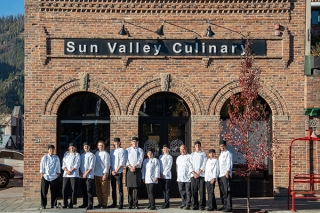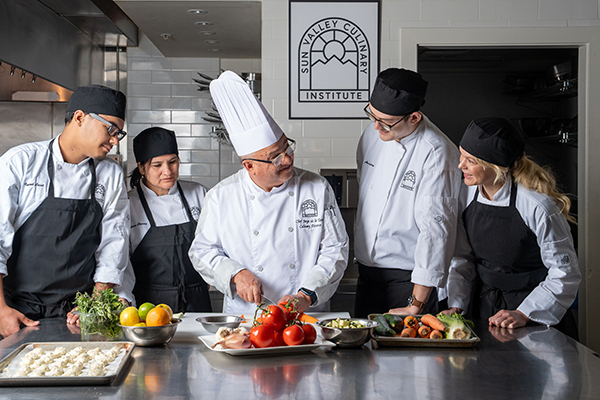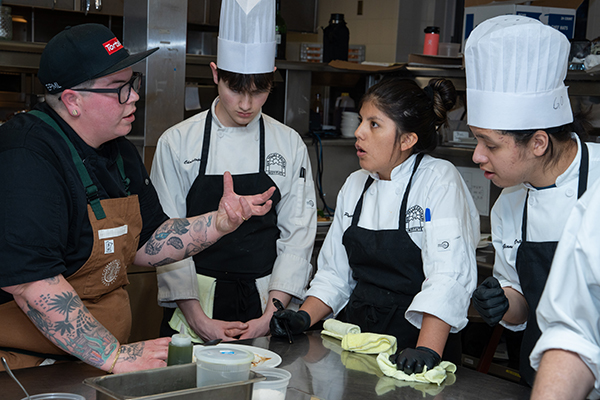
The Best of Both Worlds: Classroom Training and Kitchen Mentoring
03 January 2025Sun Valley Culinary Institute illustrates how students can pursue a cost-effective education featuring classroom instruction and mentoring in professional kitchens.
By Lisa Parrish, GMC Editor
Feedback & comments: This email address is being protected from spambots. You need JavaScript enabled to view it.
A culinary education conjures up different ideas for different people. One person believes a food cost accounting class must be included while another person says a great deal of time working in a professional kitchen is essential. History shows culinary training occurred at the hand of a mentor in a kitchen until 1946 when the first U.S. culinary school opened in New Haven, Conn., which ushered in formalized classroom training for returning World War II veterans. Thus began the quandary that still rages today, how is the most effective culinary education acquired, with an educational instructor or kitchen mentor?
A non-profit culinary institute is blurring the lines by melding both educational styles into one, year-long program. The program’s graduates will have 7,000 hours of paid-kitchen work and 2,800 hours of classroom training with experienced chef instructors. The Sun Valley Culinary Institute is currently working with its second cohort of students in the blended educational paradigm.
Located in central Idaho’s Wood River Valley, the area boasts a local ski resort that sits on more than 2,000 acres at the base of two mountains. The Sun Valley Resort also has 18 dining establishments, which provide plenty of opportunities for Sun Valley Culinary Institute students to serve in and complete one of their two required externships. The upscale community also offers more than 50 restaurants and despite its population of less than 1,500 people, the area swells to more than five times its population in its busiest season – the summer. 
The goal of this unique program is to graduate truly kitchen-ready cooks. Students begin in September and after 10 weeks of classroom training, five days per week and seven hours per day they are ready to begin their first four-month externship during ski season. Karl Uri, executive director, ensures a variety of work experiences are available from breakfast/lunch services to large-scale catering operations to fine dining and opportunities in between.
The students return to the school’s kitchen in March for their second 10-week term of classroom instruction. Following the additional classes, students launch into their second externship in June during the area’s busy summer tourist season.
“We try and give the students different experiences in different parts of the industry,” Uri said. “When they graduate school they have two professional connections and references.” The goal is for students to work in two unique professional kitchens. Though not accredited, the program is a Registered Apprenticeship Program with the U.S. Department of Labor, which means that during the students’ time off-site, the mentors are required to provide a checklist of skills training.
Each yearly student cohort is limited to 12 people by design: the school’s training kitchen is located in a refurbished restaurant. “Our kitchen is small by design, so the students understand the dance that needs to go on in a professional kitchen,” said Uri.
Students must have some prior kitchen experience to enter the program. The curriculum during the first classroom training session is a traditional model focused on topics such as safety and sanitation; knife skills; cooking soups, stocks, and sauces; and basic cooking principles like sauté, braise, broil and poach. The first session leans heavily on skill repetition. “We might teach chicken in weeks two, four, six and seven,” Uri explained. “We want to develop students’ skills. Also, we want them to be able to go into a kitchen and be clean, organized and set up a station.”
 The second classroom term focuses on broadening the students’ palates by focusing on global food flavors and cooking techniques. “We provide our students more information about food (during the second term),” Uri said.
The second classroom term focuses on broadening the students’ palates by focusing on global food flavors and cooking techniques. “We provide our students more information about food (during the second term),” Uri said.
With students utilizing the school’s kitchen space for 20 weeks out of the year, Uri offers the community culinary education and experiences through cooking classes, pop-up dinners with special chefs and culinary events. The historic facility is also available to be rented for special occasions. Engaging the community with culinary events has also helped build the school’s underwriting of students’ tuition. “This is an affluent town and they love us,” Uri said. “We are the only option for postsecondary education in the area.”
Sun Valley Culinary Institute’s tuition is calculated on a student’s financial circumstances and prior year’s income, but typically costs about $15,000, according to Uri. However, much of the students’ costs have been underwritten through grants and donations. “Our goal is that our students will graduate without academic debt,” he said. “We do all we can to ensure that happens.”
The first cohort of four students began in March 2020 and was quickly hampered by COVID-19. Ten students filled the second cohort and will graduate in the fall of 2025. The school is now looking to fill its 12 available slots for the 2025-26 cohort.
Uri believes this melded culinary education model is scalable to other communities that have two distinctive tourist seasons. “I am working on identifying the next place,” he said. He is considering options such as Park City, Utah, or Aspen, Colo.. He is searching for a community with a convertible restaurant space and a willingness to support a cooking school. If this endeavor should take off and land in several other locations, perhaps it will answer the question of which is better a classroom culinary education or education in kitchen? If you ask Uri, it’s both.
Photo Credit: Lasso Photography
